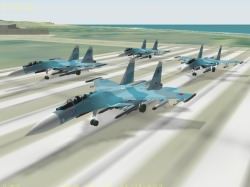| Flanker 2 Interview
by Dan "Crash" Crenshaw |
||||
|
After my first E3 preview, Carl Norman and I discussed some changes and features that were not shown at E3. I have since had a chance to put the latest beta through its paces and talk to Carl about more of the items featured. Q. In my first preview I mentioned the limited detail on many of the aircraft. I see that there have been considerable additions to the texture files and bit maps. Is there still more to come or is this beta reaching the level of graphics we can expect? CN - All of the aircraft textures have been replaced since E3. Work on enhancing the aircraft and objects is a continuous process. The artists responsible for aircraft textures are constantly working on improving the look of each aircraft. The ground detail is also much richer than what was displayed at E3. The cities and towns have a wide variety of building types. There are many monuments and historic sites depicted in our model of the Crimea.
 Q. What type of frame rates are you seeing? CN - That depends upon many factors. Everything from scenario size to number of aircraft or objects present. On a Pentium II with an AGP card, I've had a medium sized mission running between 12 and 33 frames per second. With the highest graphics detail enabled, Flanker 2.0 demands fast processing and fast video. We strongly recommend that if you want the best performance at the highest levels of detail, you should have a top of the line AGP card. Q. What are the minimum system specs expected to be for these types of frame rates? CN - As I stated, there are many factors to the frame rate, so the machine specs alone are not the answer. Scenario size and number of objects is just as critical. At present, we are stating that the minimum specs are a Pentium 200 with 32 MB of RAM, DirectX compatible 3D video card. We recommend a Pentium 300 or greater with as much RAM as possible and an AGP video card. Personally, I am using a Pentium 450 and 128 MB of RAM with a Riva TNT2 card and have had great performance. A very large scenario with hundreds of objects will still slow things down even on this high-end set-up. The bigger and faster your system, the better the performance. |
 Q· What graphics APIs are going to be supported? CN - AGP, Voodoo 2 and above. Q· What will the resolution choices be? CN - 640x480, 800x600, and 1024x768. Q· There was talk that the graphics would be scalable from 1.5 levels up to the full blown 2.0 levels. Is this still planned? CN - I wouldn't use V1.5 as a benchmark for this product since this is a completely new graphics engine, but yes, the level of detail can be adjusted in such areas as: Terrain Detail Levels, Texture Resolution, Object Density, Greenery Density, Roads & Rivers, and Detail Visibility. Q· Can you talk a little on how the terrain was done, low and high level? CN - The Team utilized stereoscopic satellite photography that was previously classified. Models were made of the terrain features and textures added. The rest is secret! (Grin) The buildings, monuments, and historical landmarks are the result of intense research, to include visits to the Crimea by the artists. Q. The mission editor has been enhanced since the original. Can you tell us the new additions and tweaks we can expect? CN - It is still very similar to the original with some enhancements to the interface making it easier to use. The map is very detailed and can be zoomed down to cracks in the runway. Static objects and buildings can be viewed in detail. There is now an improved targeting system that allows the user to assign targets at individual waypoints. One of the main enhancements is a much greater selection of units in the Order of Battle. We are including the Campaign Editor as an unadvertised feature. It's a bit more complicated to use than the Mission Editor, but we are confident that the hard core Flanker Faithful will be putting out campaigns on the Internet at the cyclic rate. Go to Part II
|
|||
|
Copyright © 1997 - 2000 COMBATSIM.COM, INC. All Rights Reserved. Last Updated September 1st, 1999 |
||||
